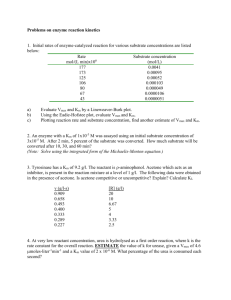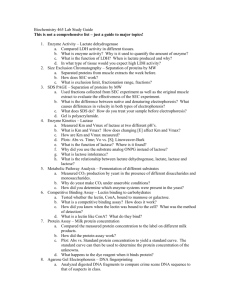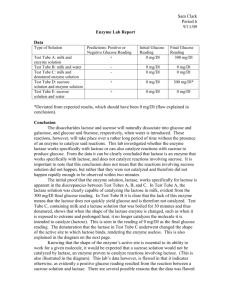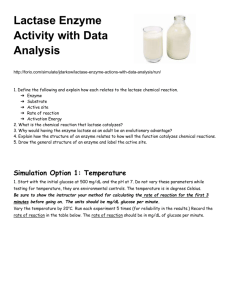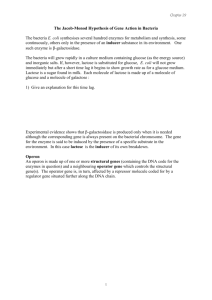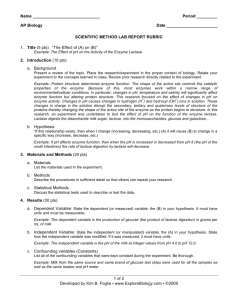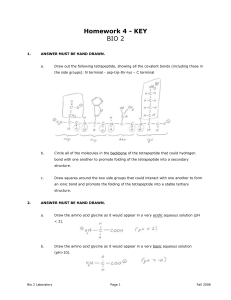What effects do enzymes have on chemical reactions
advertisement
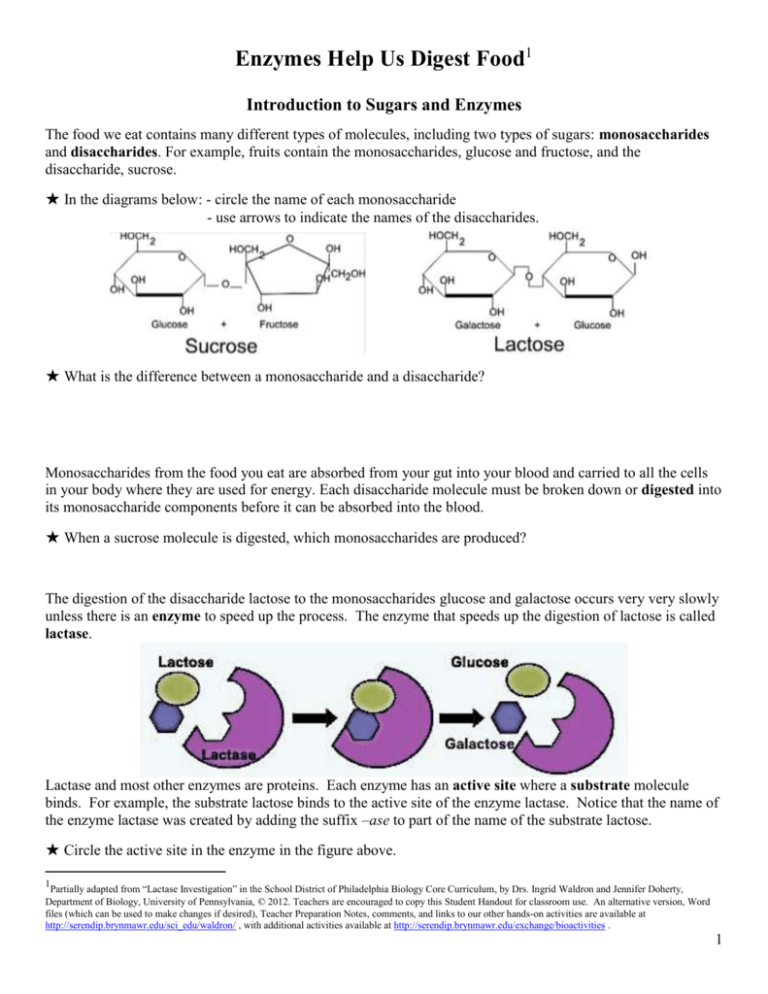
Enzymes Help Us Digest Food1 Introduction to Sugars and Enzymes The food we eat contains many different types of molecules, including two types of sugars: monosaccharides and disaccharides. For example, fruits contain the monosaccharides, glucose and fructose, and the disaccharide, sucrose. ★ In the diagrams below: - circle the name of each monosaccharide - use arrows to indicate the names of the disaccharides. ★ What is the difference between a monosaccharide and a disaccharide? Monosaccharides from the food you eat are absorbed from your gut into your blood and carried to all the cells in your body where they are used for energy. Each disaccharide molecule must be broken down or digested into its monosaccharide components before it can be absorbed into the blood. ★ When a sucrose molecule is digested, which monosaccharides are produced? The digestion of the disaccharide lactose to the monosaccharides glucose and galactose occurs very very slowly unless there is an enzyme to speed up the process. The enzyme that speeds up the digestion of lactose is called lactase. Lactase and most other enzymes are proteins. Each enzyme has an active site where a substrate molecule binds. For example, the substrate lactose binds to the active site of the enzyme lactase. Notice that the name of the enzyme lactase was created by adding the suffix –ase to part of the name of the substrate lactose. ★ Circle the active site in the enzyme in the figure above. 1 Partially adapted from “Lactase Investigation” in the School District of Philadelphia Biology Core Curriculum, by Drs. Ingrid Waldron and Jennifer Doherty, Department of Biology, University of Pennsylvania, © 2012. Teachers are encouraged to copy this Student Handout for classroom use. An alternative version, Word files (which can be used to make changes if desired), Teacher Preparation Notes, comments, and links to our other hands-on activities are available at http://serendip.brynmawr.edu/sci_edu/waldron/ , with additional activities available at http://serendip.brynmawr.edu/exchange/bioactivities . 1 An enzyme speeds up a chemical reaction which converts a substrate or substrates to a product or products. The products are released from the enzyme and the enzyme returns to its original state, so the enzyme is ready to act on another substrate molecule. Thus, an enzyme molecule can be reused over and over. For example, a single molecule of the enzyme lactase can speed up the digestion of many many molecules of lactose. ★ The following equation shows the digestion of lactose. Lactase Lactose --------- > Glucose + Galactose Use E to indicate the enzyme, S to indicate the substrate, and P to indicate the products. Circle the molecule that is a protein, and use arrows to indicate the molecules that are sugars. Experiment 1 - Can the sugar lactose be digested without any enzyme? To find out whether the enzyme lactase is needed to digest the sugar lactose, you will test whether lactose breaks down to glucose and galactose in two different conditions: (1) with no enzyme and (2) when the enzyme lactase is present. ★ First, predict what you think will happen. For each column, circle the equation that describes what you think will happen. Prediction with No Enzyme Prediction with the Enzyme Lactase No Enzyme Lactose -------- > Glucose + Galactose Lactase Lactose -------- > Glucose + Galactose Or Or No Enzyme Lactose -------- > Lactose (no glucose produced) Lactase Lactose -------- > Lactose (no glucose produced) To test whether your predictions are correct, you will use glucose test strips to test whether glucose has been produced. Procedure 1. One member of your group should prepare Tube 1 with 10 mL of lactose solution. 2. Another member of your group should prepare Tube 2 with 10 mL of lactose solution and 1 mL of lactase solution. Put on a glove, put your thumb on the top of the tube and turn the tube upside down several times to mix the two solutions. 3. Wait 3 minutes to allow time for lactose to break down to glucose and galactose. 4. While you are waiting, both of the experimenters should get a test strip. Notice that the original color of the test strip is aqua. In the next step, if the test strip turns green, olive or brown, this will indicate that glucose is present. 5. After the 3 minute wait, each experimenter should dip a glucose test strip into the solution in his or her tube until the pad is submerged, and then remove the test strip immediately and run the edge of the strip against the rim of the tube to wipe off excess liquid. 2 Results ★ Wait 1 minute and then record your results in the table below. Tube 1 - 10 mL of lactose solution Tube 2 - 10 mL of lactose solution + 1 mL of lactase solution Test strip color Was there any change in the color of the test strip? Conclusion ___ no glucose produced ___ some glucose produced ___ no glucose produced ___ some glucose produced Interpretation ★ Was the sugar lactose digested without any enzyme? ★ Was the sugar lactose digested when the enzyme lactase was present? ★ Do your results match your predictions? ___ yes ___ no If yes, what conclusion do your results support? If no, what do you think is the reason for the difference between your predictions and results? ★ In Tube 2, there were over 5000 lactose molecules for each molecule of lactase. How can a single lactase molecule break down many many lactose molecules? (Hint: See the top of page 2.) Experiment 2 - Can the same enzyme digest lactose and sucrose? To answer this question, you will use your results from Experiment 1 and you will design a second experiment to test whether the enzyme lactase can digest the disaccharide sucrose. For this second experiment you will have available the same supplies as you used in Experiment 1 and also a sucrose solution. Write down your procedures and create a data table. Ask your teacher to check these, and then carry out your experiment and record your results. 3 Interpretation ★ Did lactase break down sucrose? How do you know? ★ Does the same enzyme digest lactose and sucrose? ___ yes ___ no Your results illustrate a general principle called enzyme specificity. Enzymes act only on specific substrates. In many cases an enzyme can only react with a single kind of substrate. For example, lactase can digest lactose, but not other types of disaccharide sugars. ★ Which part of an enzyme is responsible for this enzyme specificity? (Hint: See the bottom of page 1.) Because of enzyme specificity, our bodies need lots of different enzymes to digest different types of food molecules. For example, our small intestine has the enzyme lactase to digest lactose and a different enzyme to digest sucrose. ★ What do you think is the name of the enzyme that digests sucrose? (Hint: See the bottom of page 1.) ★ Complete the following equation to show the digestion of sucrose. Include the enzyme and the products. Sucrose ---------- > Experiment 3 - Do we need the enzyme lactase to digest milk? Some people have trouble digesting milk because their bodies do not make the enzyme needed to digest the sugar in milk. Design an experiment to test whether lactase is needed to digest the sugar in milk. You will have available for this experiment the same supplies as you used in Experiment 1 and milk. Write down your procedures and create a data table. Ask your teacher to check these, and then carry out your experiment and record your results. 4 Interpretation ★ Is lactase needed to digest the sugar in milk? How do you know? ★ Which sugar does milk contain: glucose, lactose or sucrose? How do you know? ★ Suppose that the cells in a person's body do not make lactase. What do you think would happen to the lactose molecules in the milk that person drinks? Human babies and the babies of all other mammals depend on milk for their nutrition. All babies produce the enzyme lactase to digest lactose, which is the main sugar in milk. In contrast, many adults produce very little lactase, so they can only digest very small amounts of lactose. When a person who produces very little lactase consumes large amounts of lactose in a short time period, most of the lactose is not digested in the small intestine and lactose reaches the large intestine where it is digested by bacteria. This can result in symptoms such as diarrhea, flatulence, and discomfort. This condition is called lactose intolerance. ★ Name some foods that might result in discomfort for a person who is lactose intolerant. People who are lactose intolerant can buy lactose-free milk to gain the benefits of the protein, calcium and vitamin D that milk provides. ★ How do you think lactose-free milk is made? ★ Do you think lactose-free milk contains glucose? If yes, where did the glucose come from? ___ yes ___ no ★ Milk contains many other types of molecules in addition to lactose. The table below shows two types of molecules and an ion that are contained in milk. Enzymes are needed to digest large molecules (e.g. disaccharides) into smaller molecules (e.g. monosaccharides) that can be absorbed into the blood. Small molecules and ions can move into the blood without being digested by enzymes. Complete the second column of the table. Molecule or ion Are enzymes needed to digest this type of molecule or ion? If digestive enzymes are needed, what type of smaller molecule is produced? Calcium (Ca++) Proteins Water (H2O) 5

